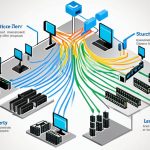A backbone network, also known as a core network, is key to computer networks. It connects different networks, letting them share information. This central infrastructure makes sure data moves fast and communication is smooth.
Backbone networks are essential for our digital lives. They help connect LANs, subnetworks, and big companies with many locations. These networks can handle more data than the networks they link1. They can connect networks in a building, across a campus, or over long distances. The Internet backbone is a well-known example of a backbone network.
Key Takeaways:
- Backbone networks connect different networks, making information sharing and smooth connectivity possible.
- They are crucial for our digital world, supporting LANs, subnetworks, and big companies with many locations.
- The capacity of a backbone network is usually more than the networks it connects1.
- Examples include the Internet backbone and other networks that link networks in a building, across a campus, or over large areas.
History of Backbone Networks
The idea of a backbone network started with the telephone core network. This network was all about handling voice calls. It was key in routing calls across the Public Switched Telephone Network (PSTN) and offering services to users.
It connected different sub-networks, making sure information could move between them2. Today, backbone networks have grown to support many data services and technologies.
Functions of Backbone Networks
Backbone networks are key to how computer networks work and stay connected. They do important tasks that help data move smoothly and keep networks running well3. Let’s look at some main roles of backbone networks:
1. Aggregation
Backbone networks bring together data from many sources, making it easier to manage and process3. They collect data from different parts of the network. This makes information flow better and helps with analysis.
2. Routing and Switching
Backbone networks move data packets to where they need to go, across the network3. They use protocols like BGP and OSPF to send data efficiently between different parts of the network3.
3. Redundancy and Failover
Redundancy and failover are key to keeping backbone networks up and running3. They have extra connections and systems ready to go if something fails. This keeps the network running smoothly even when there are problems.
4. Authentication and Security
Backbone networks use strong security to keep data safe and stop unauthorized access3. They have firewalls and security tools to check and protect the network from threats.
5. Traffic Management
Backbone networks manage traffic by making sure important data gets through first3. They use tools from Network Management Systems to keep the network running well. This helps use network resources wisely and avoid congestion.
These key functions make backbone networks the backbone of computer networks. They provide the structure for smooth data flow and reliable connections3.
Types of Backbone Networks
Backbone networks are the core of data transmission and connectivity. They come in different types, each with its own benefits for various needs.
Serial Backbone
The serial backbone connects devices in a line. But, the distributed backbone is more common and has more benefits4.
Distributed Backbone
This type of backbone grows easily by adding new layers. It’s great for expanding networks as they grow. It’s a top choice for modern networks because it’s easy to scale4.
Collapsed Backbone
This network connects many LANs to a central hub. It makes managing the network easier. But, having all connections through one router can be risky if it fails45.
Parallel Backbone
This network has extra connections for reliability. If one connection goes down, others can still work. But, it needs more cables, which costs more to install and maintain4.
Choosing the right backbone network depends on the organization’s needs and goals. It’s important to think about what each type offers before making a decision.
How Backbone Networks Work
Backbone networks are key to moving data across the internet. They act as the main structure of the internet, offering fast and reliable connections. This makes sure data moves quickly and without delay.
Fibre optic cables are a big part of backbone networks. They send data as light pulses. This method is super fast and can send lots of data over long distances without losing quality.
Backbone networks use special devices like routers and switches to manage data. These devices make sure data gets to where it needs to go fast.
These networks are set up to connect different parts of the internet smoothly. They use Internet Protocol (IP) and Multiprotocol Label Switching (MPLS) to route data well. This helps manage traffic and make sure important data gets priority.
Backbone networks have different types of connections. They use low-capacity, high-capacity, and satellite links together. This mix makes the network strong and less likely to break.
They also have special switches and high-capacity circuits. These help move a lot of data between different parts of the network quickly.
They use special methods to keep the network running even if one part fails. This makes the network more reliable and less likely to stop working.
Packet switching is a key way backbone networks send data. It helps them use traffic patterns well and seems like circuit-switched networks to users. This way, data moves efficiently based on the network’s conditions.
In short, backbone networks use fibre optic cables, special devices, and protocols for fast and reliable data transfer. They have many connections and methods to keep data moving well. This makes them a strong base for the internet6.
Backbone Network vs Access Network
Backbone networks and access networks are key parts of computer networks. They have different jobs in moving data and keeping connections strong. Knowing how they work is key to making networks better and improving user experience.
A backbone network is the main part of a big network. It links different places, data centers, ISPs, and countries together. It makes sure data moves fast and smoothly over long distances7. These networks use high-speed fiber optic cables to carry lots of data for the internet and big companies7. This keeps connections strong and meets the needs of big networks and ISPs.
An access network, or the “last mile,” connects users to the network. It links users to the internet through wired or wireless links like cables or mobile networks7. This part of the network makes sure users can get online and use network services.
The distribution network sits between the backbone and access networks. It helps move traffic to local or regional networks7. This network makes sure data gets to where it needs to go, linking the backbone to users through the access network.
Key Differences and Functions
| Backbone Network | Access Network |
|---|---|
| Connects large enterprises, ISPs, and entire countries | Connects end-users or subscribers to the internet |
| High-capacity core infrastructure | Delivers connectivity to end-users |
| Facilitates global data exchange | Provides direct access to the internet |
| Utilizes high-bandwidth fiber optic cables | Uses wired or wireless connections |
| Handles massive data loads | Ensures end-user access to network services |
| Ensures redundancy for network availability | Focuses on last-mile connectivity |
Choosing between a backbone network and an access network depends on what an organization or user needs. Backbone networks focus on big infrastructure and global connections. Access networks focus on getting users online quickly and reliably. Knowing how these networks work is key to managing and improving networks.
Backbone networks and access networks have different roles in computer networks. Backbone networks connect big companies, ISPs, and countries. Access networks make sure users can get online. The distribution network helps move data between them.
Understanding the roles of backbone and access networks helps network managers and companies build strong networks. Combining these networks makes a network reliable and efficient7.
Backbone Network Solutions
Backbone networks are key for good network performance and keeping connections strong. Neos Networks in the UK is a top choice for reliable backbone networks. They offer advanced optical connectivity services that help businesses build strong and efficient networks.
Neos Networks is an expert in backbone networks and backhaul services. These services help businesses improve their network performance and keep connections smooth across all operations. With their top-notch optical solutions, Neos Networks helps businesses send data fast and keep connections strong. This is vital for today’s digital world.
Neos Networks is big on redundancy. This means they make sure data keeps moving even if the network goes down. They have set up systems and places that work together to cut down on downtime and keep the network reliable.
Being able to grow is important for backbone networks. As businesses get bigger and need more data, they need a network that can grow with them. Neos Networks offers solutions that can change to meet business needs. This lets businesses grow their networks easily and get ready for the future.
Neos Networks also focuses on security. With more cyber threats out there, businesses need strong security for their networks. Neos Networks uses the latest security tech and rules to protect data and keep the network safe.
Neos Networks has solutions for different business needs across many industries. Their services include:
- Optical backbone networks
- Backhaul solutions
- Network redundancy and backup
- Network security
- Scalable network infrastructure
- 24/7 network monitoring and support
With Neos Networks’ wide range of backbone network solutions, businesses get better network performance and smooth connections. Choosing Neos Networks means businesses can make their digital setup better and have a strong base for their data.
As the need for strong and growing network solutions gets bigger, Neos Networks is leading the way. They offer new backbone network solutions that help businesses succeed in the digital age.
Neos Networks Backbone Network Solutions
| Services | Description |
|---|---|
| Optical Backbone Networks | High-speed optical connectivity for seamless data transmission and performance optimization. |
| Backhaul Solutions | Efficient backhaul services to connect remote locations and ensure reliable network connectivity. |
| Network Redundancy and Backup | Implementation of redundant systems and facilities to minimize downtime and maximize network reliability. |
| Network Security | Advanced security protocols and technologies to protect against cyber threats and ensure data integrity. |
| Scalable Network Infrastructure | Flexible network solutions that can adapt to changing business needs and accommodate future growth. |
| 24/7 Network Monitoring and Support | Continuous monitoring and dedicated support to ensure network performance and resolve any issues promptly. |
Neos Networks offers a wide range of backbone network solutions for businesses. With their help, businesses can confidently move forward with their digital plans and get top-notch connectivity and network performance8.
Importance of Backbone Networks
Backbone networks are key for connectivity, performance, and reliability in large-scale networks. They connect different parts of a network, making sure data moves smoothly. Their strong design and large capacity make them essential for keeping networks running well.
Handling lots of data is a big job for backbone networks. With more digital info and a need for fast, reliable connections, these networks are vital. They make sure data moves quickly and reliably, whether it’s within a company or between networks.
Scalability is a big plus for backbone networks. As networks grow, so does the need for more connections and data flow. These networks can grow with businesses, keeping data moving smoothly. This lets businesses grow without losing speed or performance.
Backbone networks are built for top performance and reliability. They use the latest tech and protocols, like IEEE 802.1q9, for secure data transfer. Features like single-switch VLANs and multiswitch VLANs9 help manage network traffic. Fiber optic cabling10 brings fast internet speeds and more room for growth.
Reliability is crucial for backbone networks. They keep networks connected and running smoothly. Fiber optic cabling’s strength and resistance to interference10 make it a reliable choice.
Backbone networks support more than just IT. They’re like the backbone of the body, supporting and connecting different parts. In biology, the protein backbone is key to protein structure and function11. In tech, it’s a central part of software development, making it easier to organize and grow11. For us, it’s the spinal column, supporting our body and protecting our spinal cord11.
Here are some great resources to learn more about backbone networks:
- Detailed analysis of backbone networks and their role in distribution and core
- Insights into how a fiber optic backbone network can save valuable
- Understanding the importance of backbone networks in the digital
Backbone networks are crucial for keeping large-scale networks running smoothly. They’re the backbone of modern communication and data flow, supporting businesses in many fields.
Future of Backbone Networks
As technology gets better, backbone networks will become more important. They will help meet the increasing need for internet connections.
The backbone network is like the backbone of the internet. It connects different networks around the world. This ensures we can all stay connected12.
New tech like 5G, IoT, and cloud computing will make us rely more on backbone networks. These changes mean we need faster and more reliable networks. They must handle more data and support new technologies12.
To meet these new needs, backbone networks will change a lot. They must be able to grow and change quickly. This will help them keep up with new tech and keep connections strong12.
Software-Defined Networking (SDN) is a big change for backbone networks. SDN makes networks more flexible, efficient, and smart. It lets us control networks better and make them more adaptable12.
Adding Artificial Intelligence (AI) to networks makes them smarter. They can predict and act on problems quickly. This helps protect against cyber threats and keeps data safe12.
SDN also helps manage networks better by segmenting them based on rules. This makes handling big data easier and improves network security12. It helps businesses and users get the most out of their networks12.
Virtual Local Area Networks (VLANs) are becoming more common in networks. They help control access, improve performance, and follow the law12.
Looking forward, AI will change how we watch over networks. It will help spot problems fast and fix them before they get worse12.
Companies like Equinix are working on making backbone networks better. They help businesses grow, set up network hubs, and use virtual services to improve connections and speed12.
The future of backbone networks will need ongoing innovation and teamwork. We must keep up with new tech to meet the internet’s growing needs12.
Benefits and Future of Backbone Networks
Backbone networks are key to our connected world. They ensure fast data transfer and reliable communication. These networks are crucial for businesses, organizations, and individuals.
They make data transfer efficient and fast, keeping communication smooth. With more data needs, backbone networks are vital. They handle large amounts of data quickly.
Technology is making backbone networks better. For example, 400G technology has boosted their data capacity. By 2023, 400G will be used in many networks, from local to long-distance ones13.
Backbone networks are also getting more energy-efficient. Companies like ZTE have made modules that use less energy, making networks greener13. This helps reduce power use and lessen their environmental impact.
Data is key in our connected world. Backbone networks will support growth in 5G, cloud computing, and IoT. These technologies need fast and reliable connections. Backbone networks provide the infrastructure for this.
In public transport, backbone networks are vital. They improve train automation and security. These networks make systems more efficient, safe, and customer-friendly14. They help with monitoring, fixing problems quickly, and ensuring service continuity.
The Future of Connectivity
The need for backbone networks will keep growing. Technology makes us rely more on them for connectivity. They will handle more data, go faster, and reach farther13. This is important for new tech like machine-type communications and low-latency services13.
Backbone networks will also get better at security and surveillance. As we connect more, keeping networks safe and secure is key. Strong security is needed to protect against cyber threats.
In conclusion, backbone networks are vital for our digital world. They ensure fast data transfer and support new technologies. As technology advances, backbone networks will keep evolving. They will shape the future of communication and connectivity1314.
Conclusion
Backbone networks are key to our digital world, making sure we can connect, communicate, and send data. They help businesses, ISPs, and data centers work well. This makes sure everything runs smoothly.
Back in the day, backbone networks were more spread out. Now, a few big companies like Google, Amazon, and Facebook lead the internet world. They changed how we search, shop online, use mobile devices, and connect with others. (source)
New tech and our need for more connections have led to better backbone networks. These networks use different designs and tech like fast Ethernet and automation. They make sure data moves fast and reliably, helping businesses stay on top of their game. (source)
With more online threats, fast networks are key for keeping data safe. They let us do things like shop online, stream videos, and play games in real-time. Having more bandwidth means data moves quicker, making streaming and video calls smoother. It also helps businesses grow and adapt quickly. Adding redundancy makes networks more secure and reliable, which is vital for keeping businesses running. (source)1516
FAQ
What is a backbone network?
A backbone network connects different networks, letting them share information. It’s the main part of a computer network. It makes sure data moves fast and communication is smooth.
What is the role of a backbone network?
Backbone networks connect LANs, subnetworks, and big companies across locations. They offer strong connections within buildings, campuses, or wide areas.
How did the concept of backbone networks originate?
Backbone networks started from the telephone core network, handling voice calls. This core network routed calls and offered services to users through the access network.
What are the functions of backbone networks?
Backbone networks are key in computer networks. They handle tasks like aggregating data, routing, switching, and managing traffic. They also ensure security and redundancy.
What are the types of backbone networks?
Backbone networks come in various types, like serial, distributed, collapsed, and parallel backbones. Each type has its own network topology.
How do backbone networks work?
They provide fast, reliable connections for data transfer. Using fiber optic cables, routers, and switches, they keep communication smooth between subnetworks.
What is the difference between a backbone network and an access network?
Backbone networks connect regions, data centers, and ISPs to the internet. Access networks link users to the network’s distribution.
What backbone network solutions are available?
Neos Networks offers backbone and backhaul services in the UK. They provide optical connectivity for better connectivity and growth.
Why are backbone networks important?
Backbone networks are key for network performance. They ensure reliable and scalable connections for big networks. They help businesses and organizations that need strong network connections.
What is the future of backbone networks?
As technology grows, backbone networks will be more important. They’ll need to adapt to new tech and keep providing efficient connections.
What are the benefits and future of backbone networks?
Backbone networks bring many benefits like smooth connectivity, fast data transfer, reliability, and growth. They’re essential for large networks and will shape future communication and connectivity.
Source Links
- https://en.wikipedia.org/wiki/Backbone_network – Backbone network
- https://en.wikipedia.org/wiki/Internet_backbone – Internet backbone
- https://phoenixnap.com/glossary/backbone-network – What Is a Backbone Network? | phoenixNAP IT Glossary
- https://fiberbit.com.tw/types-of-backbone-networks/ – No title found
- https://www.tutorialspoint.com/types-and-uses-of-backbone-networks – Types and Uses of Backbone Networks
- https://www.encyclopedia.com/computing/dictionaries-thesauruses-pictures-and-press-releases/backbone-network – backbone network | Encyclopedia.com
- https://geeksforgeeks.org/what-is-backbone-network/ – What is Backbone Network?
- https://www.tatacommunications.com/knowledge-base/network-core-network-explained/ – What is a core network? How does the core network work?
- https://medium.com/@brianmwambia3/exploring-backbone-networks-understanding-distribution-and-core-layers-c6d2b619423a – Exploring Backbone Networks: Understanding Distribution and Core Layers
- https://www.buildingsiot.com/blog/how-a-fiber-optic-backbone-network-can-save-you-down-time-bd – How a Fiber Optic Backbone Network Can Save You Down Time
- https://www.linkedin.com/pulse/importance-backbone-dr-senthil-kumar-chandrasekaran-cghgc – Importance of Backbone
- https://blog.equinix.com/blog/2024/03/13/protect-against-future-threats-with-a-programmable-backbone-network/ – Protect Against Future Threats With a Programmable Backbone Network
- https://www.ccsinsight.com/blog/concerned-about-internet-growth-get-400g-backbone/ – Concerned About Internet Growth? Get 400G Backbone – CCS Insight
- https://www.belden.com/markets/mass-transit/connected-backbone-and-occ-networks – Connected Backbone and OCC Networks
- https://callwave.com/backbone-network/ – What Is Backbone Network? – CallWave
- https://www.worldstream.com/en/news/a-solid-network-backbone–the-core-for-any-it-infrastructure – A Solid Network Backbone – The Core for IT Infrastructures | Worldstream



















